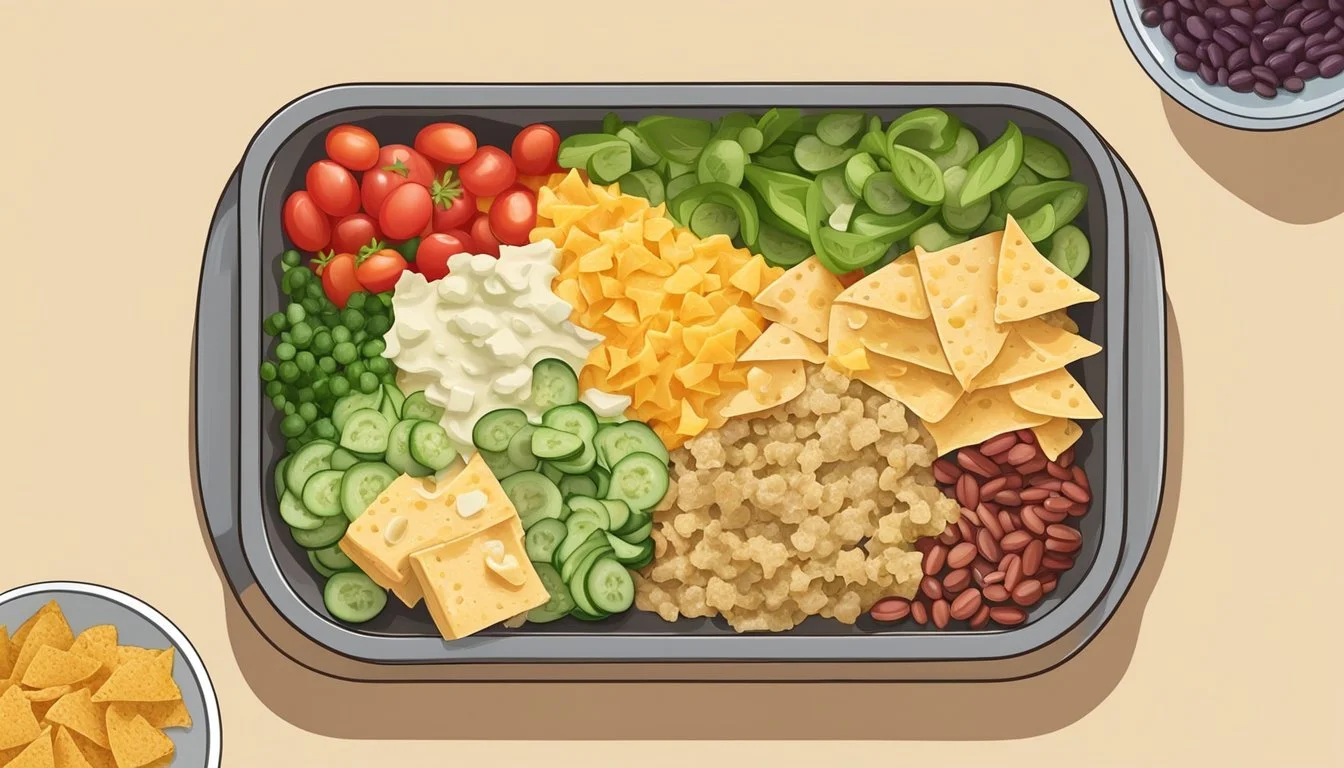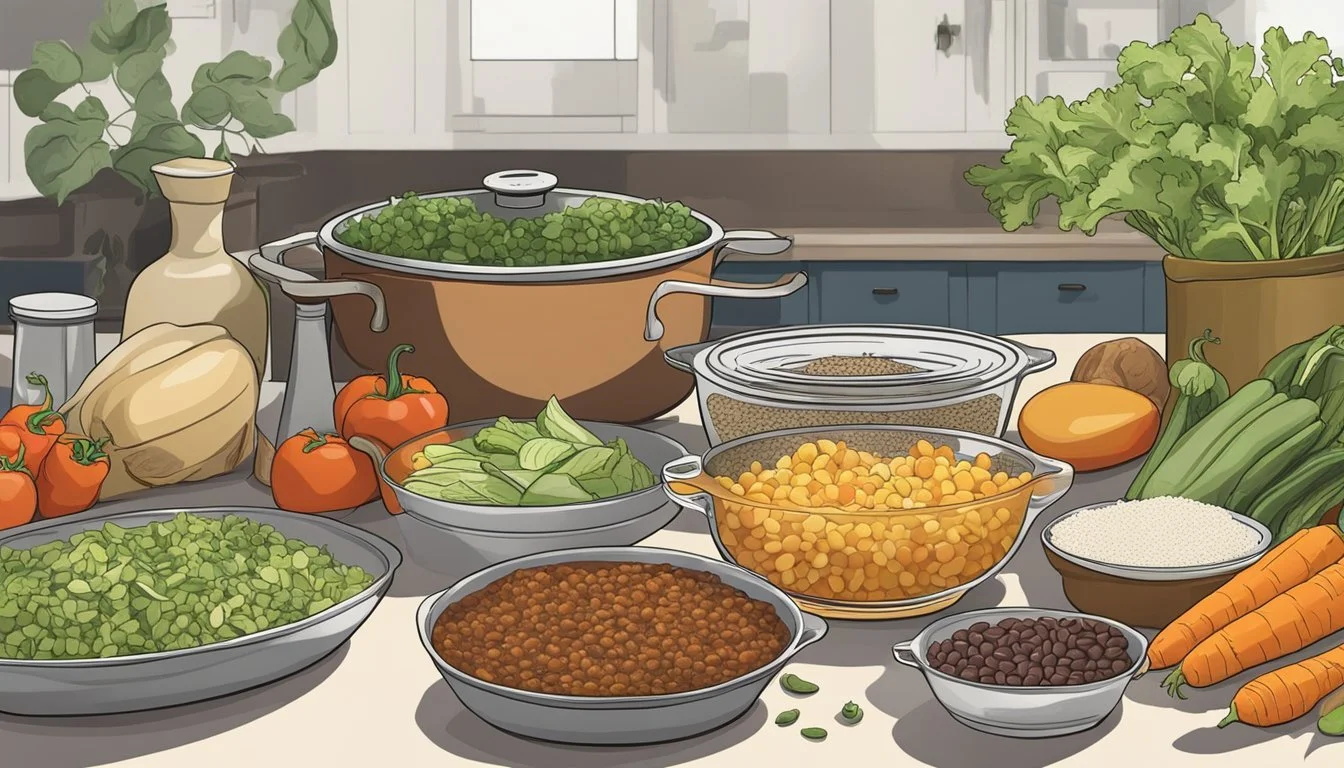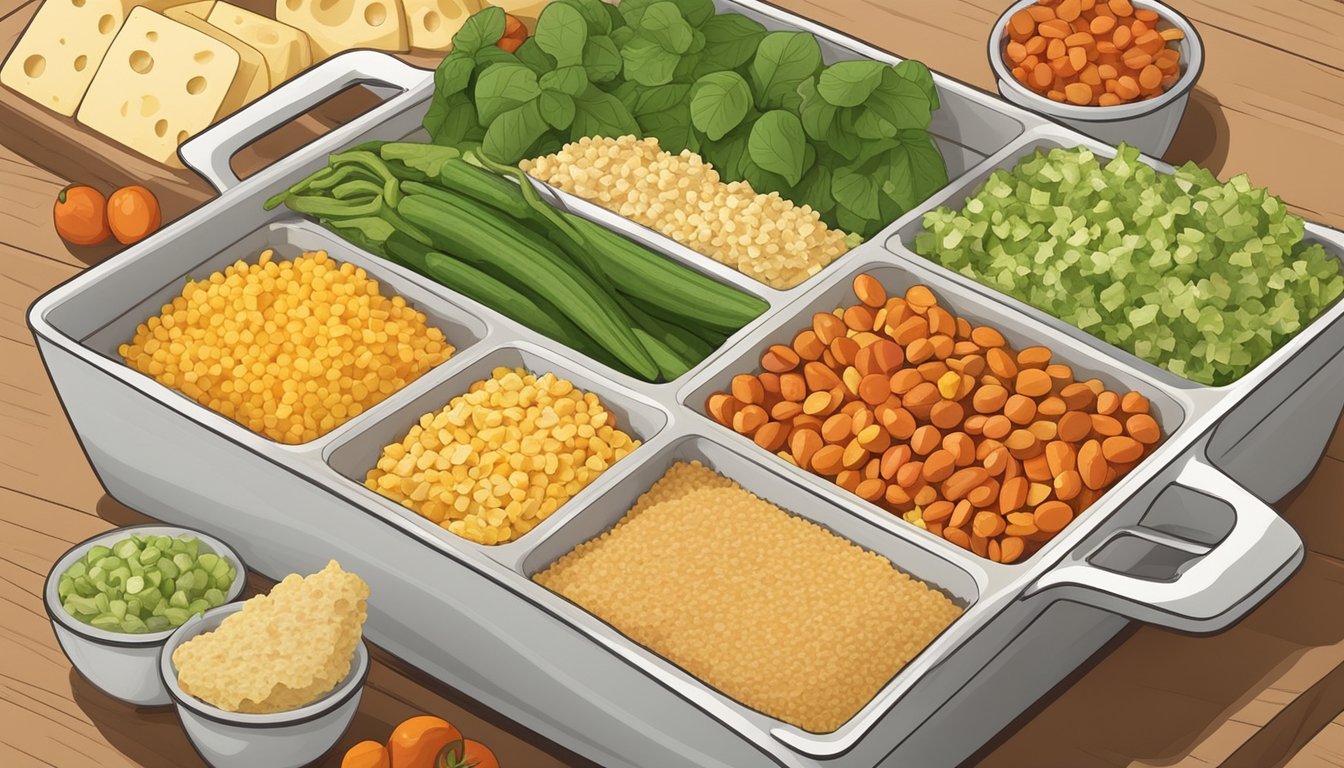How to Prepare a Tex-Mex Vegetarian Casserole
A Step-by-Step Guide
Tex-Mex cuisine combines the flavors of the southwestern United States and Mexico to create dishes that are both vibrant and comforting. A Tex-Mex vegetarian casserole fits perfectly into this tradition, offering a hearty and flavorful option for a main course at dinner. This dish is a celebration of beans, peppers, spices, and cheese layered together to create a meal that is satisfying for both vegetarians and meat-eaters alike.
Crafting a Tex-Mex vegetarian casserole involves a symphony of ingredients that are familiar to the palate, yet combined in a way that is uniquely satisfying. The base often includes cooked rice or tortillas, layered or mixed with an assortment of vegetables, such as onions, (What wine goes well with onions?) bell peppers, and jalapeños. These are seasoned with traditional spices such as cumin, chili powder, and garlic, which lend depth and warmth to the dish.
This main course is not only a medley of flavors but also a versatile canvas for customization. Chefs can experiment with different beans, such as black or pinto, and choose from a variety of cheeses, including cheddar or a Mexican cheese blend, to top their casserole. The result is a versatile dish that serves as comfort food while also providing a nutritious and satisfying dinner option.
Selecting Your Ingredients
The foundation of a delectable Tex-Mex vegetarian casserole lies in a well-considered selection of fresh vegetables, hearty proteins, and rich cheese varieties. Each ingredient brings its unique flavor and texture to the dish, creating a satisfying and balanced meal.
Vegetables Choices
A colorful array of vegetables not only provides essential nutrients but also enhances the casserole with a variety of textures and flavors. Key options include:
Corn: A staple in Tex-Mex cuisine, corn adds sweetness and crunch.
Onion: A base for any casserole, onions should be sautéed until translucent to bring out their natural sweetness.
Tomatoes: Fire-roasted tomatoes offer a smoky flavor, while fresh ones provide a tangy juiciness.
Peppers: Including a mix of red bell pepper and green bell pepper gives a sweet yet slightly bitter taste.
Zucchini: This adds a gentle, earthy flavor and becomes wonderfully tender when cooked.
Jalapeno: For those who appreciate heat, jalapenos can be finely diced and added for a spicy kick.
Avocado: Although not traditionally baked, fresh avocado can be used as a creamy garnish before serving.
Protein Alternatives
Tex-Mex casseroles (What wine goes well with casseroles?) often include a source of protein to make the dish more filling:
Black Beans: These are high in fiber and protein, making them an excellent main ingredient for vegetarians.
Other Beans: Options like pinto beans or kidney beans can be included for variety.
Tofu or Seitan: (What wine goes well with seitan?) For an added protein boost, tofu or seitan can be seasoned and included, mimicking a meatier texture.
Cheese Varieties
Cheese adds creamy richness to the casserole and can be selected based on desired flavor and melting characteristics:
Mexican Blend Cheese: A pre-shredded mix that melts easily and imparts a traditional Tex-Mex flavor.
Cheddar: A classic choice that offers a sharp taste and satisfying melt.
Monterrey Jack or Pepper Jack: These varieties melt well and can add a mild or spicy flavor respectively.
Vegan Cheese: For a dairy-free option, there are various vegan cheeses available that can be used as substitutes.
When choosing ingredients, one should consider how each will interact with the others in terms of taste, texture, and moisture content to ensure a cohesive and delicious casserole.
Cookware and Kitchen Tools
The right cookware and tools are essential for preparing a Tex-Mex vegetarian casserole efficiently and effectively. From the choice of casserole dish to the utensils for preparation, understanding these key items ensures a smooth cooking process.
Casserole Dish Selection
A casserole dish is central to this recipe due to its use in both the preparation and baking of the dish. For a Tex-Mex casserole, a 9×11 or similar-sized dish, made of ceramic or glass, is ideal because it distributes heat evenly for consistent cooking. One should also consider a dish that's both oven-proof and appealing for table presentation.
Preparation Utensils
Proper preparation utensils include:
Skillet: A large skillet is crucial for sautéing vegetables and spices. It should offer good heat conduction — cast iron or stainless steel are excellent choices.
Spatulas and Spoons: Heat-resistant spatulas and wooden spoons are perfect for stirring and mixing the ingredients without damaging the skillet surface.
Measuring Spoons and Cups: Accurate measures of spices like cumin and wet ingredients like olive oil ensure that the flavors are balanced.
Cutting Board and Knife: A durable cutting board and a sharp knife are needed to chop vegetables such as onions and bell peppers neatly and safely.
Preparation Steps
In crafting a Tex-Mex vegetarian casserole, meticulous preparation lays the groundwork for a flavorful dish. Chopping and dicing the vegetables ensure consistent cooking, while sautéing them builds a savory foundation.
Chopping and Dicing
One begins by prepping the vegetables. Onions and garlic should be peeled and finely chopped to release their aromatic flavors. Both diced tomatoes and any additional vegetables, such as bell peppers, should be cut into uniform pieces to achieve even cooking throughout the casserole.
Onions: Peel and finely chop.
Garlic: Peel and mince.
Diced Tomatoes: If using whole tomatoes, dice into small cubes.
Prep Time: Allocating approximately 10-15 minutes for this step can streamline the cooking process.
Sautéing Vegetables
After the vegetables are prepped, the cook should heat a drizzle of olive oil in a large sauté pan over medium heat. They begin by adding the onions, cooking them until they're translucent, about five minutes. Garlic is then added and cooked for an additional minute, ensuring it does not burn. One can add diced tomatoes at this stage if the recipe calls for them, sautéing until the vegetables are well-combined and seasoned.
Heat oil on medium heat.
Add onions, cook until translucent (roughly 5 minutes).
Stir in garlic, cook for one more minute.
The proper sautéing not only softens the veggies but also infuses them with rich, deep flavors, setting the stage for an impressive Tex-Mex vegetarian casserole.
Assembling the Casserole
When one assembles a Tex-Mex vegetarian casserole, each ingredient layer contributes distinct flavors and textures, while cheese serves as a flavorful sealant that melds the components together during baking. This process is crucial to achieving the layered complexity that characterizes a well-made casserole.
Layering Ingredients
The foundation of a Tex-Mex vegetarian casserole begins with a salsa and refried beans mixture spread along the bottom of the dish. This not only prevents sticking but also infuses the casserole with a zesty starting layer. One then continues by layering corn tortillas over this base. The tortillas act as the structure of the casserole, absorbing flavors and providing a substantial texture.
To continue, ingredients such as black beans, corn, diced green chiles, and additional salsa are layered in with the tortillas. These should be uniformly distributed to allow each bite to be flavorful. This process is repeated, creating multiple layers, which will help to distribute flavors and textures evenly throughout the casserole.
Cheese Topping
The final touch before the casserole enters the oven is the cheese topping. For optimal coverage and a perfect melt, one should evenly sprinkle a generous layer of shredded cheese over the top layer of the casserole. The cheese will act as a binding agent for the layers beneath it and also create a deliciously golden crust when baked. Common choices for cheese in Tex-Mex dishes include cheddar, Monterey Jack, or a blend of both.
The type and amount of cheese can vary according to preference, but the goal is a melty and slightly crispy top that covers all the ingredients. Once the casserole is topped with cheese, it's ready to be baked to perfection.
Seasoning and Spices
Spices and herbs are essential for imparting the rich, multifaceted flavors characteristic of Tex-Mex cuisine. For a vegetarian casserole, the balance of seasonings can transform simple ingredients into a complex and savory dish.
Spice Selection
For the foundation of Tex-Mex flavors, cumin, chili powder, and smoked paprika are non-negotiable spices. They impart a warm, earthy taste and rich color to the dish.
Salt: Acts as a flavor enhancer, bringing out the other spices' profiles.
Cumin: Offers a nutty, spicy taste that is quintessential in Tex-Mex dishes.
Chili Powder: Adds a mild to moderate heat and deepens the overall flavor.
Garlic Powder: Provides a concentrated, earthy element to the spice mix.
Onion Powder: Delivers a subtle sweetness and astringency, enhancing the casserole’s savoriness.
Smoked Paprika: Lends a smoky undertone and vibrant color to the casserole.
It's recommended to season the dish to taste, but typically, one can start with one teaspoon of each spice, adjusting as needed.
Herb Garnishing
Herbs add a fresh contrast to the deep and smoky spices. They should be used with a mindful hand to not overpower the dish.
Oregano: This robust herb contributes a slightly bitter, peppery flavor.
Cilantro: Fresh cilantro leaves sprinkled on top of the casserole before serving add a refreshing, lemony kick.
Dried herbs can be included into the spice mix before cooking, while fresh herbs like cilantro are best added after the casserole is cooked to preserve their vibrant flavor and color. A pinch of sea salt can also be sprinkled over the top with the cilantro for an extra pop of flavor.
Cooking the Casserole
To prepare a vegetarian Tex-Mex casserole, one requires attention to detail and precision in both preparation and cooking times. The oven should be preheated — a crucial step for even cooking. An appropriate temperature is typically around 350°F to 400°F (175°C to 205°C), depending on the specific recipe or desired crust on top of the casserole.
The baking dish, once chosen, is to be lightly greased to prevent sticking. For the Vegetarian Enchilada Casserole, layering is key. Ingredients such as tortillas, salsa, onions, and refried beans are arranged in the dish with cheese. Additional layers can incorporate vegetables like bell peppers, black beans, or corn to enhance the flavor profile. Each layer is carefully assembled before topping with a final sprinkle of cheese.
The baking time is substantial to the success of the dish. It can range from 20 to 35 minutes. Patience is required to achieve a bubbling, golden-brown top that indicates a well-cooked casserole. Cook times may vary slightly based on the oven and the depth of the casserole.
Stage Time Preheat Oven 10-15 minutes Bake Casserole 20-35 minutes
Total Time for preparing and cooking a vegetarian Tex-Mex casserole will generally be around 30 to 50 minutes, factoring in both oven preheating and bake time. Food safety and doneness can be checked by ensuring the casserole reaches an internal temperature of 165°F (74°C) if using any ingredient that needs cooking.
It's important for the cook to allow the casserole to rest for a few minutes after baking. This waiting period enhances the flavors and ensures the casserole sets, making it easier to cut into portions.
Serving Suggestions
The right garnishes and side dishes can transform a Tex-Mex Vegetarian Casserole into a feast for the eyes and palate. Think complementary textures and flavors that enhance the main dish.
Garnishes
A scattering of fresh toppings can add both color and zest to the casserole. Here are some preferred garnishes:
Sour Cream: A dollop on top adds a creamy texture and cools down spicy flavors.
Avocado: Sliced or diced, it contributes a buttery richness.
Cilantro: Chopped finely, it lends a fresh, herby note.
Green Onion: Sliced green onions provide a sharp, oniony bite.
Side Dishes
Including one or two side dishes can round out the meal. Consider these sides for a harmonious balance:
Rice: A spoonful of fluffy rice can absorb the casserole's bold sauces.
Tortilla Chips: Offer crunch and are perfect for scooping up the casserole.
Nutritional Information
A Tex-Mex Vegetarian Casserole can be a wholesome meal that contains an array of nutrients beneficial for a balanced diet. The nutritional profile of this dish may vary depending on the specific recipe and portion size, but generally, it includes a mix of macronutrients and micronutrients essential for health.
Calories: The caloric content of a serving of Tex-Mex Vegetarian Casserole typically ranges from 200 to 300 calories, making it a suitable option for those mindful of their energy intake.
Protein: Beans and cheese are excellent sources of protein. A serving might contain between 8 to 12 grams of protein, which is crucial for muscle repair and growth.
Fiber: The vegetables and beans contribute to the dietary fiber content, which aids in digestion and can help maintain healthy blood sugar levels. A typical serving could offer 4 to 6 grams of fiber.
Carbohydrates: As a source of complex carbohydrates, the rice or tortillas in the dish provide sustained energy. Expect around 35 to 50 grams of carbohydrates per serving.
Sugars: This casserole is generally low in sugars unless added corn or certain salsas increase the count slightly. However, the sugar content is usually minimal, around 2 to 5 grams per serving.
Fat: Varying with the use of cheese and oils, the total fat content might be around 7 to 15 grams, with saturated fat kept to a minimum by choosing low-fat cheese options. It's essential for flavor and satiety.
Sodium: The sodium level can be moderated by selecting low-sodium beans and sauces. An average serving can have 300 to 600 milligrams of sodium.
By incorporating a variety of vegetables, beans, and spices, a Tex-Mex Vegetarian Casserole delivers a host of nutrients without compromising on taste. Additionally, the meal can potentially be categorized as healthy when it's prepared with fresh ingredients and controlled portion sizes.
Storage and Leftovers
When it comes to storing leftovers of your Tex-Mex vegetarian casserole, proper techniques ensure that the casserole remains as delicious as when first prepared.
Refrigeration: Leftovers should be allowed to cool to room temperature before covering them with a tight-fitting lid or plastic wrap to prevent bacterial growth. They can be refrigerated for up to 3-4 days. When reheating, they should be brought to at least 165°F to ensure food safety.
Allocate portions: To make reheating easier, divide leftovers into single-serving containers.
Airtight containers: Use these to maintain freshness and prevent contamination.
Freezing: For longer storage, the casserole can be frozen. Here's how to effectively freeze leftovers:
Cool completely: Before freezing, ensure the casserole is completely cooled to prevent ice crystals from forming.
Wrap securely: Use freezer-safe wraps or containers to guard against freezer burn and odor absorption.
Label and date: Clear labeling prevents the "mystery meal" scenario and allows for effective meal planning.
Meal Prep: The casserole can be prepared in advance and either refrigerated for a few days until ready to bake or frozen. If frozen, it may need an extended cooking time directly from the freezer, or one can thaw it overnight in the refrigerator before baking.
To reheat, one can utilize either the microwave for quick thawing and heating or an oven for a more even, crisp result. Containers should always be microwave-safe or oven-safe accordingly. Use caution when handling hot containers and evenly distribute heat to preserve the texture and flavors of your casserole.
Alternative Variations
Tex-Mex vegetarian casseroles can be adapted to suit various dietary needs and flavor preferences. Below are specific suggestions for vegan options and meat add-ins for those who aren't strictly vegetarian.
Vegan Options
In a Tex-Mex casserole, traditional dairy products can be easily substituted with plant-based alternatives. Cheese can be replaced with vegan cheese varieties that melt well, such as those made from cashews or soy. Sour cream can be substituted with a vegan version, typically made from coconut milk or soaked cashews blended to a creamy consistency. For a vegan quesadilla casserole, use vegan cheese and tortillas that do not contain dairy or lard. Refried beans are a common ingredient but ensure they are not prepared with animal fats—many brands offer explicitly vegan refried beans.
Cheese Substitute: Vegan cheese (cashew, soy-based)
Sour cream Substitute: Vegan sour cream (coconut, cashew-based)
Tortillas: Check for lard-free, 100% plant-based
Meat Add-Ins for Non-Vegetarians
For those who incorporate meat, adding ground beef is a popular way to increase the protein content of a Mexican casserole. Ensure the beef is browned and seasoned with typical Tex-Mex spices like cumin and chili powder before layering it into the casserole. If one is preparing a Mexican lasagna, cooked ground beef can be layered between tortillas along with beans and cheese. Enchilada casserole can also benefit from the savory addition of shredded chicken or beef, folded into the enchilada sauce and stacked with tortillas and cheese.
Ground Beef: Cook and season before adding
Mexican Lasagna: Layer seasoned beef between tortillas
Enchilada Casserole: Incorporate shredded meat into the sauce
These variations allow for flexibility and ensure that the Tex-Mex casserole can be enjoyed by a wide audience, regardless of dietary preferences.







